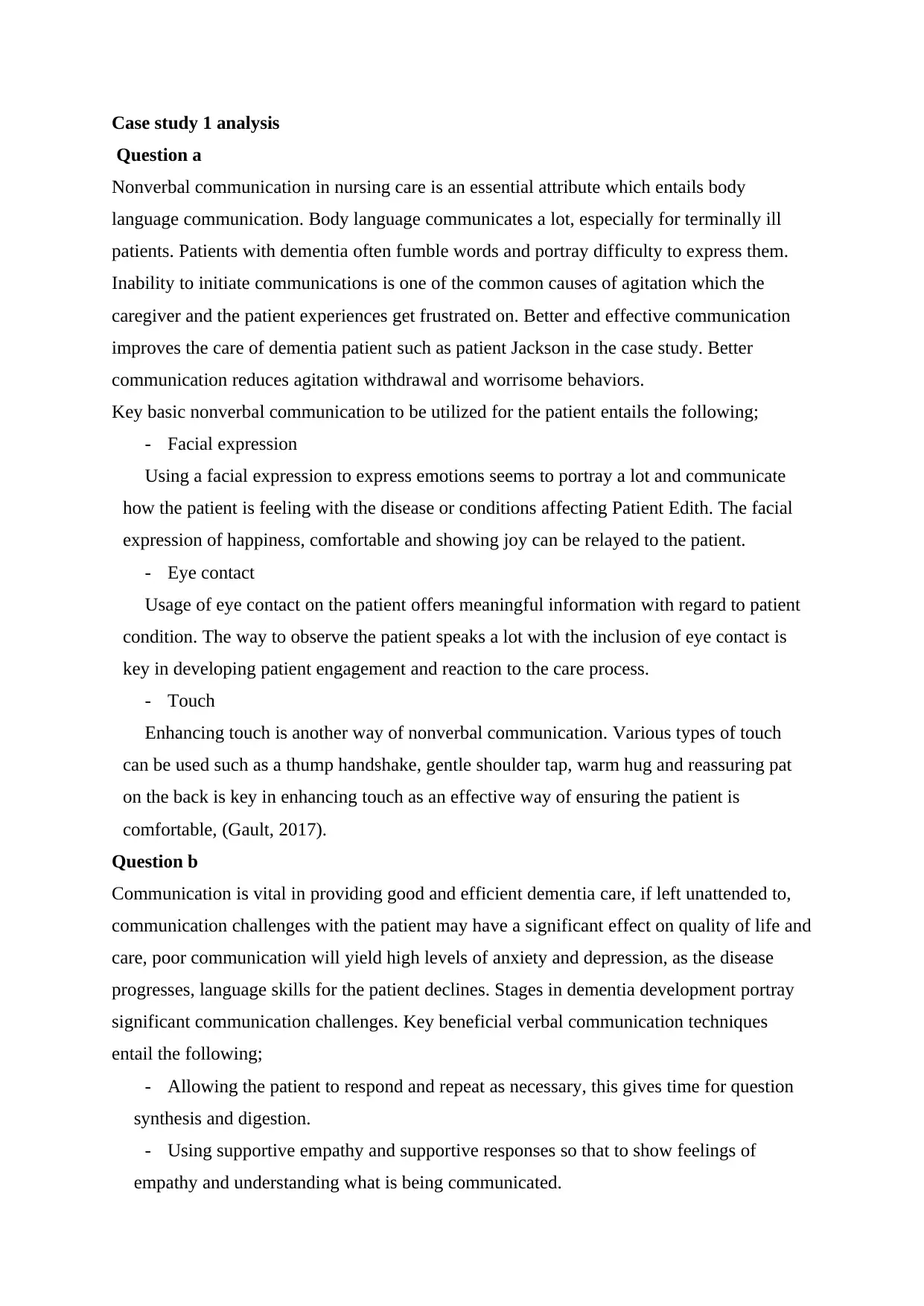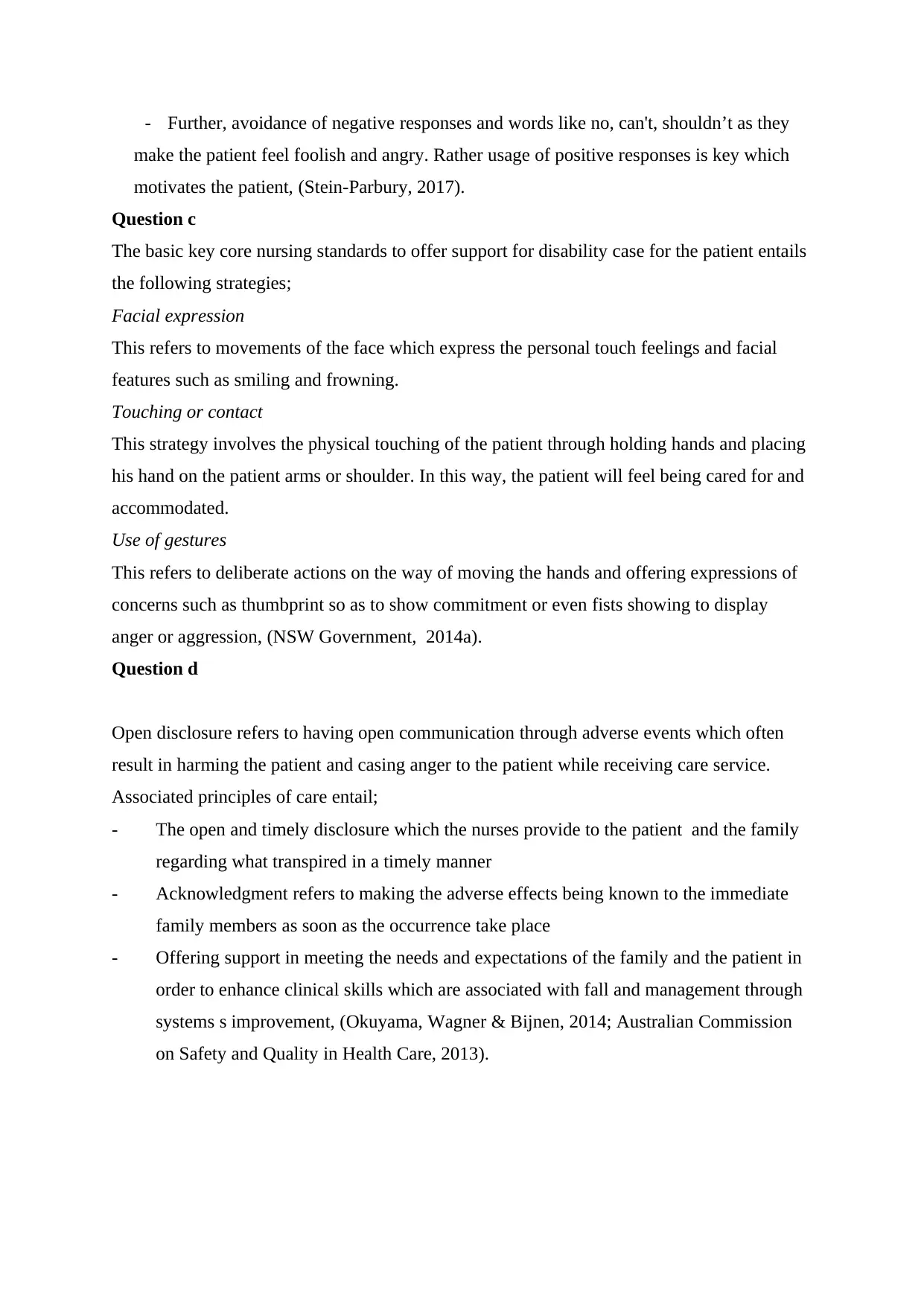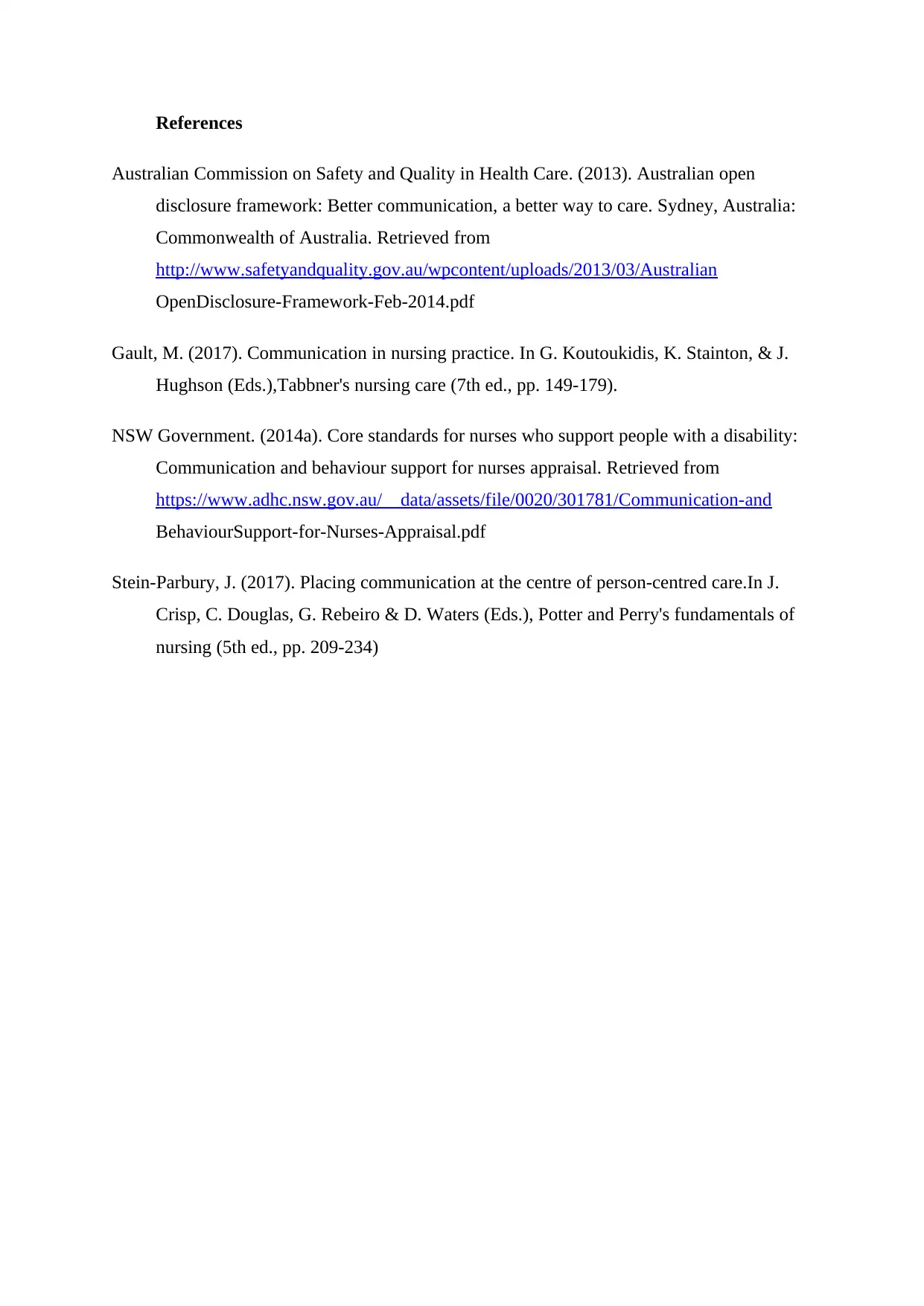Case Study 1 Analysis: Nonverbal and Verbal Communication in Nursing
VerifiedAdded on 2021/11/01
|4
|857
|48
Case Study
AI Summary
This case study analysis examines essential communication strategies in nursing, particularly focusing on dementia care. It explores the significance of nonverbal communication, such as facial expressions, eye contact, and touch, and how these can improve patient care. The analysis also delves into effective verbal communication techniques, including allowing patients time to respond and using supportive empathy. Furthermore, it outlines core nursing standards for disability support, including the use of facial expressions, touch, and gestures. The study also touches upon open disclosure principles, emphasizing timely communication and acknowledgment of adverse events to ensure patient and family needs are met. References from nursing literature are included to support the analysis.

UNIVERSITY
Task
Case study 1 analysis
Student name
Tutor
Task
Case study 1 analysis
Student name
Tutor
Paraphrase This Document
Need a fresh take? Get an instant paraphrase of this document with our AI Paraphraser

Case study 1 analysis
Question a
Nonverbal communication in nursing care is an essential attribute which entails body
language communication. Body language communicates a lot, especially for terminally ill
patients. Patients with dementia often fumble words and portray difficulty to express them.
Inability to initiate communications is one of the common causes of agitation which the
caregiver and the patient experiences get frustrated on. Better and effective communication
improves the care of dementia patient such as patient Jackson in the case study. Better
communication reduces agitation withdrawal and worrisome behaviors.
Key basic nonverbal communication to be utilized for the patient entails the following;
- Facial expression
Using a facial expression to express emotions seems to portray a lot and communicate
how the patient is feeling with the disease or conditions affecting Patient Edith. The facial
expression of happiness, comfortable and showing joy can be relayed to the patient.
- Eye contact
Usage of eye contact on the patient offers meaningful information with regard to patient
condition. The way to observe the patient speaks a lot with the inclusion of eye contact is
key in developing patient engagement and reaction to the care process.
- Touch
Enhancing touch is another way of nonverbal communication. Various types of touch
can be used such as a thump handshake, gentle shoulder tap, warm hug and reassuring pat
on the back is key in enhancing touch as an effective way of ensuring the patient is
comfortable, (Gault, 2017).
Question b
Communication is vital in providing good and efficient dementia care, if left unattended to,
communication challenges with the patient may have a significant effect on quality of life and
care, poor communication will yield high levels of anxiety and depression, as the disease
progresses, language skills for the patient declines. Stages in dementia development portray
significant communication challenges. Key beneficial verbal communication techniques
entail the following;
- Allowing the patient to respond and repeat as necessary, this gives time for question
synthesis and digestion.
- Using supportive empathy and supportive responses so that to show feelings of
empathy and understanding what is being communicated.
Question a
Nonverbal communication in nursing care is an essential attribute which entails body
language communication. Body language communicates a lot, especially for terminally ill
patients. Patients with dementia often fumble words and portray difficulty to express them.
Inability to initiate communications is one of the common causes of agitation which the
caregiver and the patient experiences get frustrated on. Better and effective communication
improves the care of dementia patient such as patient Jackson in the case study. Better
communication reduces agitation withdrawal and worrisome behaviors.
Key basic nonverbal communication to be utilized for the patient entails the following;
- Facial expression
Using a facial expression to express emotions seems to portray a lot and communicate
how the patient is feeling with the disease or conditions affecting Patient Edith. The facial
expression of happiness, comfortable and showing joy can be relayed to the patient.
- Eye contact
Usage of eye contact on the patient offers meaningful information with regard to patient
condition. The way to observe the patient speaks a lot with the inclusion of eye contact is
key in developing patient engagement and reaction to the care process.
- Touch
Enhancing touch is another way of nonverbal communication. Various types of touch
can be used such as a thump handshake, gentle shoulder tap, warm hug and reassuring pat
on the back is key in enhancing touch as an effective way of ensuring the patient is
comfortable, (Gault, 2017).
Question b
Communication is vital in providing good and efficient dementia care, if left unattended to,
communication challenges with the patient may have a significant effect on quality of life and
care, poor communication will yield high levels of anxiety and depression, as the disease
progresses, language skills for the patient declines. Stages in dementia development portray
significant communication challenges. Key beneficial verbal communication techniques
entail the following;
- Allowing the patient to respond and repeat as necessary, this gives time for question
synthesis and digestion.
- Using supportive empathy and supportive responses so that to show feelings of
empathy and understanding what is being communicated.

- Further, avoidance of negative responses and words like no, can't, shouldn’t as they
make the patient feel foolish and angry. Rather usage of positive responses is key which
motivates the patient, (Stein-Parbury, 2017).
Question c
The basic key core nursing standards to offer support for disability case for the patient entails
the following strategies;
Facial expression
This refers to movements of the face which express the personal touch feelings and facial
features such as smiling and frowning.
Touching or contact
This strategy involves the physical touching of the patient through holding hands and placing
his hand on the patient arms or shoulder. In this way, the patient will feel being cared for and
accommodated.
Use of gestures
This refers to deliberate actions on the way of moving the hands and offering expressions of
concerns such as thumbprint so as to show commitment or even fists showing to display
anger or aggression, (NSW Government, 2014a).
Question d
Open disclosure refers to having open communication through adverse events which often
result in harming the patient and casing anger to the patient while receiving care service.
Associated principles of care entail;
- The open and timely disclosure which the nurses provide to the patient and the family
regarding what transpired in a timely manner
- Acknowledgment refers to making the adverse effects being known to the immediate
family members as soon as the occurrence take place
- Offering support in meeting the needs and expectations of the family and the patient in
order to enhance clinical skills which are associated with fall and management through
systems s improvement, (Okuyama, Wagner & Bijnen, 2014; Australian Commission
on Safety and Quality in Health Care, 2013).
make the patient feel foolish and angry. Rather usage of positive responses is key which
motivates the patient, (Stein-Parbury, 2017).
Question c
The basic key core nursing standards to offer support for disability case for the patient entails
the following strategies;
Facial expression
This refers to movements of the face which express the personal touch feelings and facial
features such as smiling and frowning.
Touching or contact
This strategy involves the physical touching of the patient through holding hands and placing
his hand on the patient arms or shoulder. In this way, the patient will feel being cared for and
accommodated.
Use of gestures
This refers to deliberate actions on the way of moving the hands and offering expressions of
concerns such as thumbprint so as to show commitment or even fists showing to display
anger or aggression, (NSW Government, 2014a).
Question d
Open disclosure refers to having open communication through adverse events which often
result in harming the patient and casing anger to the patient while receiving care service.
Associated principles of care entail;
- The open and timely disclosure which the nurses provide to the patient and the family
regarding what transpired in a timely manner
- Acknowledgment refers to making the adverse effects being known to the immediate
family members as soon as the occurrence take place
- Offering support in meeting the needs and expectations of the family and the patient in
order to enhance clinical skills which are associated with fall and management through
systems s improvement, (Okuyama, Wagner & Bijnen, 2014; Australian Commission
on Safety and Quality in Health Care, 2013).
⊘ This is a preview!⊘
Do you want full access?
Subscribe today to unlock all pages.

Trusted by 1+ million students worldwide

References
Australian Commission on Safety and Quality in Health Care. (2013). Australian open
disclosure framework: Better communication, a better way to care. Sydney, Australia:
Commonwealth of Australia. Retrieved from
http://www.safetyandquality.gov.au/wpcontent/uploads/2013/03/Australian
OpenDisclosure-Framework-Feb-2014.pdf
Gault, M. (2017). Communication in nursing practice. In G. Koutoukidis, K. Stainton, & J.
Hughson (Eds.),Tabbner's nursing care (7th ed., pp. 149-179).
NSW Government. (2014a). Core standards for nurses who support people with a disability:
Communication and behaviour support for nurses appraisal. Retrieved from
https://www.adhc.nsw.gov.au/__data/assets/file/0020/301781/Communication-and
BehaviourSupport-for-Nurses-Appraisal.pdf
Stein-Parbury, J. (2017). Placing communication at the centre of person-centred care.In J.
Crisp, C. Douglas, G. Rebeiro & D. Waters (Eds.), Potter and Perry's fundamentals of
nursing (5th ed., pp. 209-234)
Australian Commission on Safety and Quality in Health Care. (2013). Australian open
disclosure framework: Better communication, a better way to care. Sydney, Australia:
Commonwealth of Australia. Retrieved from
http://www.safetyandquality.gov.au/wpcontent/uploads/2013/03/Australian
OpenDisclosure-Framework-Feb-2014.pdf
Gault, M. (2017). Communication in nursing practice. In G. Koutoukidis, K. Stainton, & J.
Hughson (Eds.),Tabbner's nursing care (7th ed., pp. 149-179).
NSW Government. (2014a). Core standards for nurses who support people with a disability:
Communication and behaviour support for nurses appraisal. Retrieved from
https://www.adhc.nsw.gov.au/__data/assets/file/0020/301781/Communication-and
BehaviourSupport-for-Nurses-Appraisal.pdf
Stein-Parbury, J. (2017). Placing communication at the centre of person-centred care.In J.
Crisp, C. Douglas, G. Rebeiro & D. Waters (Eds.), Potter and Perry's fundamentals of
nursing (5th ed., pp. 209-234)
1 out of 4
Related Documents
Your All-in-One AI-Powered Toolkit for Academic Success.
+13062052269
info@desklib.com
Available 24*7 on WhatsApp / Email
![[object Object]](/_next/static/media/star-bottom.7253800d.svg)
Unlock your academic potential
Copyright © 2020–2025 A2Z Services. All Rights Reserved. Developed and managed by ZUCOL.





